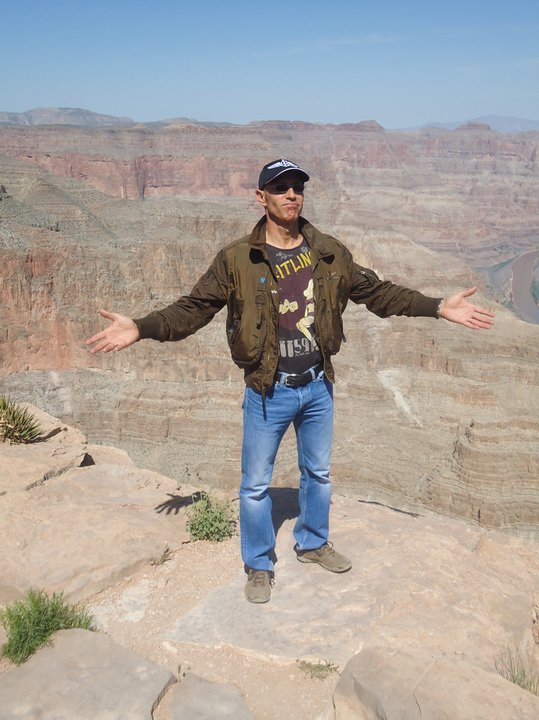

Photo (c) Jim Clash
Sometimes failure is just success in disguise. Perhaps that's what happened to Yves Rossy at the Grand Canyon last week. The Swiss aviation daredevil was scheduled to fly his jet wing-suit over the Canyon on May 6 before a group of fans and media. Rossy had long been impressed with the Canyon's challenging environment -- swirling air currents, jagged rock outcroppings and general beauty -- and chose it for his first stunt in the U.S.
The idea isn't as absurd as it might sound. Rossy, a crack aviator who piloted Mirage III supersonic fighter jets for 17 years with the Swiss Air Force, has flown his wing-suit across both The English Channel (2008) and Lake Geneva (2002). The 120-lb. device, which Rossy wears on his back, averages 125 mph and has a 79" wing span. He sends fuel to four engines with a slight roll of the hand.
The first doubts about the event came via email the day before, when the media was informed that a scheduled press conference had been canceled, but that the event itself was still a go. Everyone took it in stride, having dinner with Breitling (his sponsor) in Las Vegas that night to discuss Rossy's past achievements.
The Canyon, everyone agreed, was a different type of stunt. On Rossy's other flights, a mistake would have been dangerous, but not necessarily fatal because of a water landing in the event of an emergency. At the Canyon, though, with nearly a mile of altitude and sharp, unforgiving side walls, a snafu likely would have been fatal.
Early the next morning, a 30-minute flight brought me to Guano Point, on the western edge of the Canyon, where the stunt was to take place. The Hualapai Indian tribe, who operates the reservation and the new 70-foot Grand Canyon Skywalk there, greeted everyone with prayers and dances.
Rossy's plan was to be dropped from a helicopter, then fly his wing-suit a few hundred feet away from the Canyon walls for 10 minutes of aerobatic moves. Afterward, he would pull a parachute and land nearly a mile below where four boats were waiting on the Colorado River.
At 9:30 a.m. an announcement came, suddenly canceling the event. It said that final FAA approval for the flight had been given just 30 minutes earlier and, because of that, Rossy had no time to practice beforehand. (The FAA evidently had been contacted a month earlier, and Rossy believed he would get approval early enough for a few days of testing, but never did.)
So, after two years of planning, it wasn't weather or mechanical problems that caused the cancellation, as is usually the case with risky outdoor endeavors like this -- it was red tape.
After the decision, I had a chance to talk privately with the 51-year-old. Rossy admitted that initially he had considered trying anyway, without practice, but in the end decided against it. "I was not ready. It would be unsafe and disrespectful to my team and everybody here to present something not well prepared," he told me.
"Last night I didn't sleep," he continued. "I was doing ping-pong in my head with a knot in my stomach: 'Okay I could go, but I'm not ready because of no training. Ah, but you cannot cancel because this is a big event, a once-in-a-lifetime opportunity perhaps.' As any professional aviator knows, when you have that you don't go. I decided to cancel. I think it's the right decision."
I asked him to compare the disappointment of the moment to his delight at successfully crossing The English Channel in 2008. "What I learned there was to share," he said. "The first day I also had to cancel, but because of weather. The forecast was good for the next day, so I knew I could try again. But I wanted to just go anyway because I was on an ego trip."
"I discussed it with my team on the ferryboat. I told them, 'Hey, this is not fun. Why not?' One of them said it's because of your ego. Instead, try to think of all the people with you on your wings. Share it. So I went the next day from Calais to Dover, and it was great. I expected to experience the same here."
Sounds like Rossy has learned a thing or two about team effort since his time at the Channel.
People like Rossy aren't lunatics, by the way, but calculated risk-takers. When I interviewed the late adventurer Steve Fossett, first man to solo the globe both in a balloon and in an unrefueled aircraft, he told me of the painstaking research and practice he did before his stunts. He said, amazingly, that he didn't like being afraid. The intense preparation gave him confidence to attempt -- and succeed at -- his adventures without trepidation.
Likely, Rossy will get some practice this spring at the Canyon, and the event will happen later in the year. Stay tuned. But for now, anyway, prudence was probably the better part of valor.
